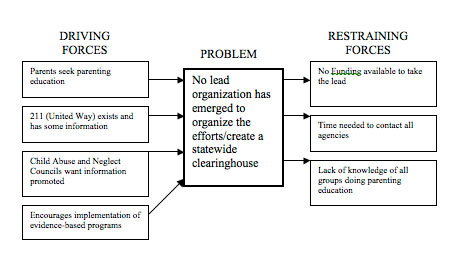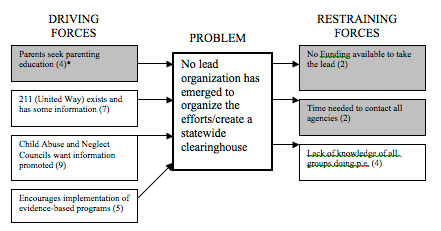 |
February 2012
|
February 2012 // Volume 50 // Number 1 // Tools of the Trade // v50-1tt3
Program Planning with Problem Mapping to Better Understand Need
Abstract
This article describes two methods for use in program development and refinement. Problem mapping and forcefield analysis are explained with a real-world example about parenting education. Both methods are visual and consider multiple causes and effects of a problem. The methods are effective for clearly thinking through a problem, identifying opportunities, partners, and programming possibilities. These methods can be used with groups to help identify problems and resulting needs, to select possible solutions, and then to use the information to design and refine programs.
There are many tools available to assist program planners with developing programs. Two useful methods include problem mapping and forcefield analysis. These methods are useful because they are visual planning tools and can be used with groups to identify problems and resulting needs, select possible solutions, and then use this information to design programs to address the needs.
As an illustration of these methods throughout this article, a parenting education research study in Maine is used. At the onset, the research group identified the lack of structure in the definition, design, and delivery of parenting education as a primary challenge in conducing the study. Using Gortner, Nichols, and Ball's (2007) framework, the group determined that no traditional organization structure existed for parenting education. Rather, the collection of agencies providing these services better represented an adhocracy (Toffler, 1970). In this adhocracy, agencies worked simultaneously towards similar goals, but typically without detailed knowledge of other agencies work or with a common understanding of the specific purposes of their work. In order to better understand the need for parenting education and who best to provide it, a problem map and forcefield analysis were conducted to inform a white paper and make recommendations about directions for programming.
Problem Mapping
In his 1991 article on concept mapping, Duttweiler (1991) details a computerized method of visually representing patterns and relationships. His method was illustrated through a fictitious example of a brainstorming session centered on the question "what are the needs of Demo County over the next four to five years that might be addressed through educational means?" Problem mapping (DePoy & Gilson, 2008) is a similar process, with its purpose being the linking of multiple views around a single problem for "the purpose of professional activity and its scrutiny" (39).
Problem mapping is useful to develop a direction for the thinking and educational planning around a specific issue. In order to conduct the problem map for parenting education, we began with a statement of the problem, "There is a lack of coordination in promoting and offering parenting education in our state."
The simple problem map is illustrated in Figure 1, and the steps included:
- Envisioning the problem as a river
- Mapping the upstream causes of the problem
- Mapping the downstream consequences of the problem
- Repeat the questions, "what are the causes?" and "what are the consequences?" and add variables upstream and downstream
Figure 1.
Abbreviated Problem Map

Forcefield Analysis
The next step in the process is to conduct a forcefield analysis. This step can help a group prioritize which causes and consequences of the problem (as illustrated in the problem map) are feasible to approach. The process of this analysis allows for the group to further examine a cause or consequence and develop a plan for assessment and change of the issue (DePoy & Gilson, 2008). It also identifies stakeholders who will be affected by the program, and resources that can help in the program's development and implementation.
To conduct the forcefield analysis as illustrated in Figures 2a and 2b, the steps included:
- Selecting one of the causal statements from the problem map
- Identifying what contributes to (drives) and inhibits (restrains) progress towards the desired goal of "alleviating part or the entire problem as stated" (DePoy & Gilson, p. 46)
- Group members identify many driving and restraining forces during this exercise
- Rank order each set of forces from 1-10 (1 represents as "bad" as it can get, and 10 represents an inactive problem) OR rank ordering can be assigned in a way that makes sense to the group
- Based on the rankings, the group selects the aspects of the problem that can be realistically addressed within the available resources of the program.
- The forcefield analysis can be used as a planning tool to revisit as the priority areas are addressed.
Figure 2a.
Abbreviated Forcefield Analysis-Step 1

Figure 2b.
Abbreviated Forcefield Analysis with Rankings-Step 2

In Figure 2b, the rankings from the forcefield analysis would lead the programmers to prioritize the aspects of this problem that concern funding, time, and knowledge. Likely next steps would involve a meeting of agencies conducting parenting education and involving them in a similar problem mapping and forcefield analysis exercise.
Once the problem map and forcefield analysis are completed, the results can be used in a number of ways:
- Set program priorities
- Inform policy (as was the case with this parenting project)
- Assign tasks to the staff most suited to respond
- Identify potential collaborators
- Set goals and objectives in the development of logic models for a program or program area.
There are software tools available, such as Freemind, to conduct mapping exercises like the problem map (Donaldson, 2010), but the exercise can easily be conducted on paper with a small group and without generating an overwhelming amount of data.
Beyond the problem mapping exercise, the forcefield analysis is very useful to set priorities, particularly when working with groups whose members may not agree about a direction for programming. It can also be useful when the group is ambivalent about the priorities.
Conclusion
Problem mapping and forcefield analysis are tools that are easy to implement and help encourage systematic thinking about problems that can be addressed by programs. In some cases, educational programs will not be the chosen direction, because other agencies and resources may be identified as best suited to address the problem. However, there will be cases when the identified problem does relate to a driving force or restraining force that can be met by Extension.
References
DePoy, E., & Gilson, S. (2008). Evaluation practice. New York: Routledge.
Donaldson, J. L. (2010). Getting acquainted with free software. Journal of Extension [On-line, 48(3) Article 3T0T7. Available at: http://www.joe.org/joe/2010june/tt7.php
Duttwiler, M. W. (1991) Concept mapping as a program planning tool. Journal of Extension [On-line], 29(3) Article 3FEA7. Available at: http://www.joe.org/joe/1991fall/a7.php
Gortner, H. F., Nichols, K. L., & Ball, C. (2007). Organization theory. Belmont: Thompson Wadsworth.
Toffler, A. (1970). Future shock. New York: Random House.




